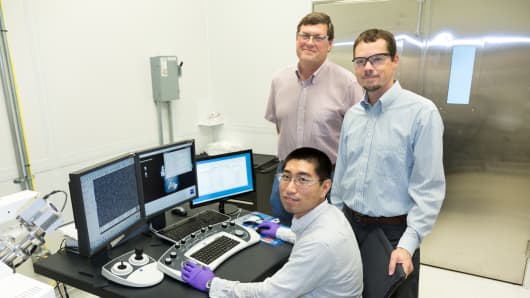Both engineers and designers hold great promise for carbon extraction and reuse. What a great way to recycle a liability into an asset and put it right back into the economy:

Oak Ridge National Laboratory, U.S. Dept. of Energy
ORNL’s Yang Song (seated), Dale Hensley (standing left) and Adam Rondinone
In a serendipitous moment of scientific discovery, a team at the U.S. Department of Energy's Oak Ridge National Laboratory (ORNL) in Tennessee has come up with a process that turns the greenhouse gas carbon dioxide into ethanol, or alcohol.
According to a release from the ORNL in October, the researchers' process uses very small "spikes" of carbon and copper to convert the carbon dioxide into ethanol.
The team applied voltage to a catalyst of carbon, copper and nitrogen, which in turn set off a complex chemical reaction. This converted a solution of carbon dioxide dissolved in water into ethanol, with a 63 percent yield, the ORNL said.
Adam Rondinone is a senior scientist at the ORNL and lead author of the study, which was published in ChemistrySelect. "In terms of impact, we're pretty excited about the idea that we can have a carbon neutral source of ethanol, and this truly is carbon neutral," he told CNBC in a phone interview.
In terms of practical applications, Rondinone indicated that the potential for their process was significant. "(The) ethanol that we make here is exactly the same as ethanol that is distilled from corn, and is exactly the same as ethanol that you drink in vodka or beer or whatever, it's the same exact molecule," he said.
While this was one avenue of interest, Rondinone went on to state that fuel was also being seen as an opportunity. "Being the Department of Energy, we're really looking at the fuel market, because this is a drop-in replacement for gasoline, for cars that are designed to run ethanol fuel at high percentages," he said.
"You can actually get a very efficient combustion process, you get a very clean combustion process … Ethanol's a great fuel, and so that's the primary market we're focused on," he added.
Alternative fuels such as ethanol, hydrogen and natural gas are becoming increasingly important. The Department of Energy's Alternative Fuels Data Center states that around 97 percent of gasoline in the U.S. has some ethanol in it, with the E10 fuel blend of 90 percent gasoline and 10 percent ethanol being the "most common blend of ethanol." Another fuel blend, E85, can contain between 51 to 83 percent ethanol.
Rondinone added that one of the key assets of his team's process was the environmental benefits compared to corn ethanol. "The main benefit of this technology, if it really pans out, is going to be the fact that it's carbon neutral," he said. "We don't require water to water corn crops, we don't require fertilizer which has to be made from natural gas, we don't require trucks or harvesters to carry the corn and ferment it," he added.
The next step was for the team to ramp up its efforts to look at the commercialization side of things and "start answering the broader economic questions regarding competitiveness, scaling and such.

No comments:
Post a Comment